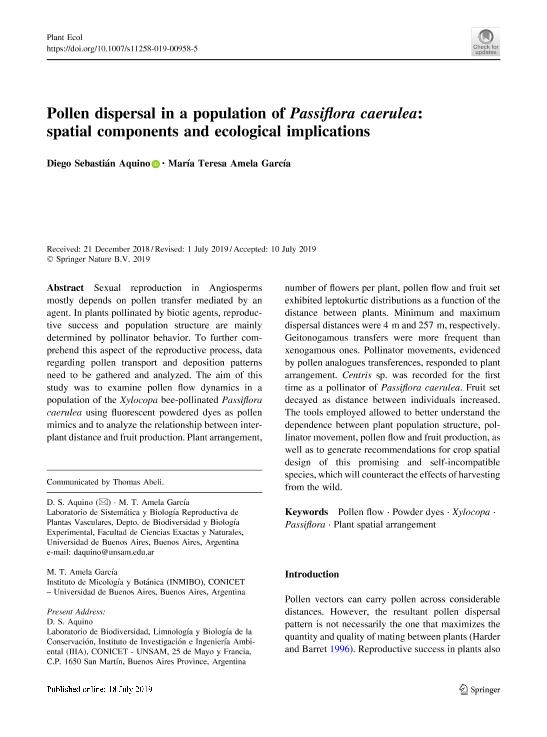Mostrar el registro sencillo del ítem
dc.contributor.author
Aquino, Diego Sebastián

dc.contributor.author
Amela Garcia, Maria Teresa

dc.date.available
2021-01-29T11:42:56Z
dc.date.issued
2019-09
dc.identifier.citation
Aquino, Diego Sebastián; Amela Garcia, Maria Teresa; Pollen dispersal in a population of Passiflora caerulea: spatial components and ecological implications; Springer; Plant Ecology; 220; 9; 9-2019; 845-860
dc.identifier.issn
1385-0237
dc.identifier.uri
http://hdl.handle.net/11336/124152
dc.description.abstract
Sexual reproduction in Angiosperms mostly depends on pollen transfer mediated by an agent. In plants pollinated by biotic agents, reproductive success and population structure are mainly determined by pollinator behavior. To further comprehend this aspect of the reproductive process, data regarding pollen transport and deposition patterns need to be gathered and analyzed. The aim of this study was to examine pollen flow dynamics in a population of the Xylocopa bee-pollinated Passiflora caerulea using fluorescent powdered dyes as pollen mimics and to analyze the relationship between inter-plant distance and fruit production. Plant arrangement, number of flowers per plant, pollen flow and fruit set exhibited leptokurtic distributions as a function of the distance between plants. Minimum and maximum dispersal distances were 4 m and 257 m, respectively. Geitonogamous transfers were more frequent than xenogamous ones. Pollinator movements, evidenced by pollen analogues transferences, responded to plant arrangement. Centris sp. was recorded for the first time as a pollinator of Passiflora caerulea. Fruit set decayed as distance between individuals increased. The tools employed allowed to better understand the dependence between plant population structure, pollinator movement, pollen flow and fruit production, as well as to generate recommendations for crop spatial design of this promising and self-incompatible species, which will counteract the effects of harvesting from the wild.
dc.format
application/pdf
dc.language.iso
eng
dc.publisher
Springer

dc.rights
info:eu-repo/semantics/openAccess
dc.rights.uri
https://creativecommons.org/licenses/by-nc-sa/2.5/ar/
dc.subject
POLLEN FLOW
dc.subject
POWDER DYES
dc.subject
PASSIFLORA
dc.subject
XYLOCOPA
dc.subject.classification
Ciencias de las Plantas, Botánica

dc.subject.classification
Ciencias Biológicas

dc.subject.classification
CIENCIAS NATURALES Y EXACTAS

dc.title
Pollen dispersal in a population of Passiflora caerulea: spatial components and ecological implications
dc.type
info:eu-repo/semantics/article
dc.type
info:ar-repo/semantics/artículo
dc.type
info:eu-repo/semantics/publishedVersion
dc.date.updated
2020-11-16T20:07:09Z
dc.journal.volume
220
dc.journal.number
9
dc.journal.pagination
845-860
dc.journal.pais
Alemania

dc.description.fil
Fil: Aquino, Diego Sebastián. Universidad Nacional de San Martín. Instituto de Investigación e Ingeniería Ambiental. - Consejo Nacional de Investigaciones Científicas y Técnicas. Oficina de Coordinación Administrativa Parque Centenario. Instituto de Investigación e Ingeniería Ambiental; Argentina. Universidad de Buenos Aires. Facultad de Cs.exactas y Naturales. Departamento de Biodiversidad y Biología Experimental. Laboratorio de Biología Reproductiva y Sistematica Experimental En Plantas Vasculares; Argentina
dc.description.fil
Fil: Amela Garcia, Maria Teresa. Consejo Nacional de Investigaciones Científicas y Técnicas. Oficina de Coordinación Administrativa Ciudad Universitaria. Instituto de Micología y Botánica. Universidad de Buenos Aires. Facultad de Ciencias Exactas y Naturales. Instituto de Micología y Botánica; Argentina. Universidad de Buenos Aires. Facultad de Cs.exactas y Naturales. Departamento de Biodiversidad y Biología Experimental. Laboratorio de Biología Reproductiva y Sistematica Experimental En Plantas Vasculares; Argentina
dc.journal.title
Plant Ecology

dc.relation.alternativeid
info:eu-repo/semantics/altIdentifier/url/http://link.springer.com/10.1007/s11258-019-00958-5
dc.relation.alternativeid
info:eu-repo/semantics/altIdentifier/doi/http://dx.doi.org/10.1007/s11258-019-00958-5
Archivos asociados
